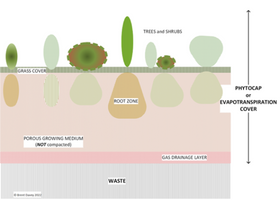
‘Conventional’ landfill graphic courtesy of Dr Brent Davey
Dr Brent Davey, Principal Environmental Consultant at Fyfe, provided a fascinating and well-attending presentation last week on ‘Landfill caps – the pros and cons of conventional and green alternatives’ in the latest HydroTerra webinar.
Dr Davey outlined that minimising the environmental impacts of landfill depends on:
- The cap’s ability to contain litter
- Minimising rainwater infiltration into the waste mass
- Minimising landfill gas emissions
- The aesthetic of the landscape once the landfill operation has stopped
Brent detailed the structure of both conventional and green, or evapotranspiration (ET), landfill caps, the challenges posed, as well as the effectiveness of both methods in achieving their aims. He concluded that while conventional landfill caps contain waste, they don’t necessarily prevent water infiltration (leading to more leachate formation) or the escape of methane. Meanwhile, ET caps can contain waste and limit leachate production, but do need care in construction and maintenance if they are to perform as intended.

‘Green’ landfill cap graphic courtesy of Dr Brent Davey
Despite ET covers being cheaper, working well and looking great, their current take-up by councils has been slow, which was another topic explored by Brent. Regardless of the method used, he also said that all caps require continuous monitoring and testing to accurately manage performance.
If you missed this fascinating webinar, you can watch the recording here.





